Mumbai: Home page/ factfile/ general issues
This is a collection of articles archived for the excellence of their content. |
Contents |
Mumbai, in brief
Atul Dodiya, November 9, 2015: India Today
Life... in a metro
An interpretation of urban life, both utopian and dystopian, and vignettes of the never-say-die spirit that allows Mumbai to go on despite literal and metaphorical attacks on its soul.
Mumbai is typified by a giant glass man pissing into the sustaining sea. All faces in this work-except Amitabh Bachchan's-are anonymous.
Sunday Morning on Marine Drive, 1995
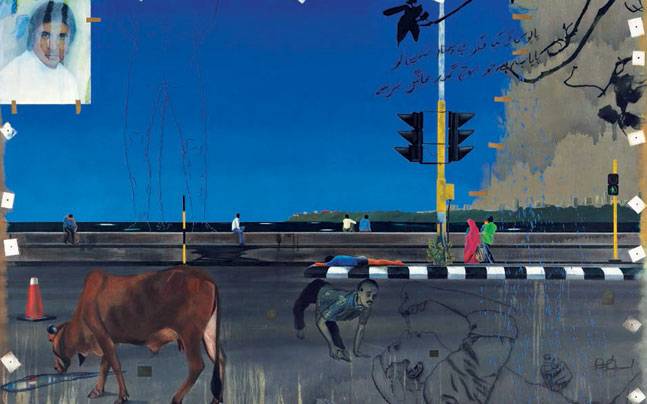
From: Atul Dodiya, November 9, 2015: India Today
The kala pani, or black water of the sea, is so addictive that even those warned by doctors to leave cannot, as signified by Dodiya's self-portrait on the right taking nasal drops. On the top right, M.F. Husain's handwriting etches urdu couplets by Faiz Ahmed Faiz.
'14 stations', 2012

From: Atul Dodiya, November 9, 2015: India Today
Indicative of Mumbai's physical and metaphorical journeys from the suburbs to the hub, the station name boards are embodied by violent, smudged villains. They twin the city's cinema and the commute: both cracked and aged in marble dust.
'Leopold', 2012

From: Atul Dodiya, November 9, 2015: India Today
When the shutter is closed, a menu lists a variety of western and Indian influences. It carries the silhouette of a liar whose modesty is covered with a fig leaf.When it is open, a poem mentions iconic eateries that have nourished our thinkers on a longitude that symbolises a metaphorical hunger.
26- 11, 2012
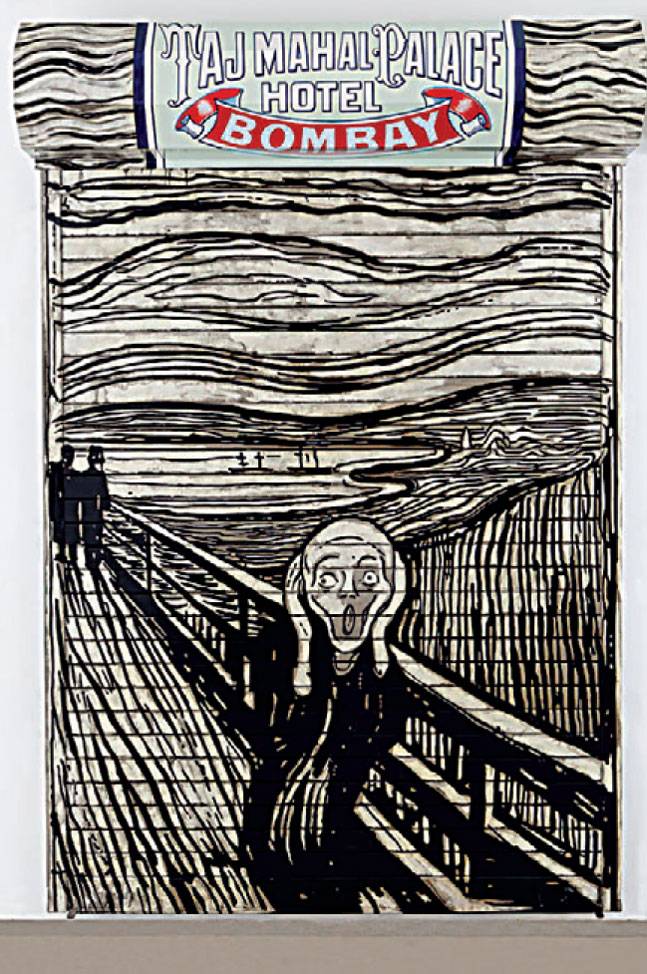
From: Atul Dodiya, November 9, 2015: India Today
Within the colonial typography of the Taj Mahal Palace hotel resounds Edvard Munch's primordial scream. A response to the terror attack of 26/11.
'Missing II (open)', 2000
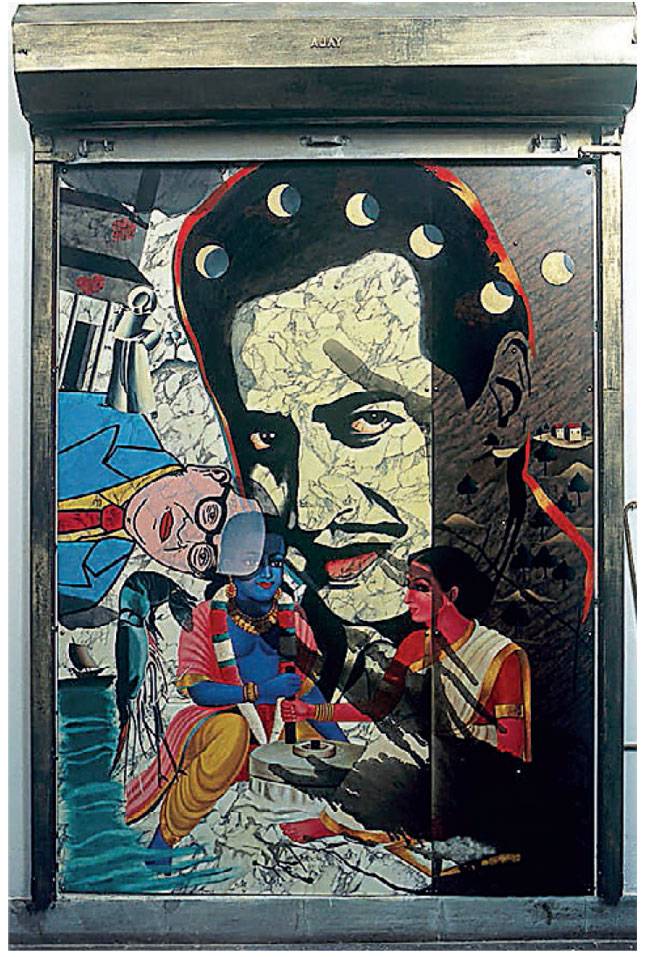
From: Atul Dodiya, November 9, 2015: India Today
Inside the shutter of a lost child is the cacophony of adult life-identity politics, the villainy of glamour, propaganda that wanes and waxes like the moon.
'Land's end', 2010
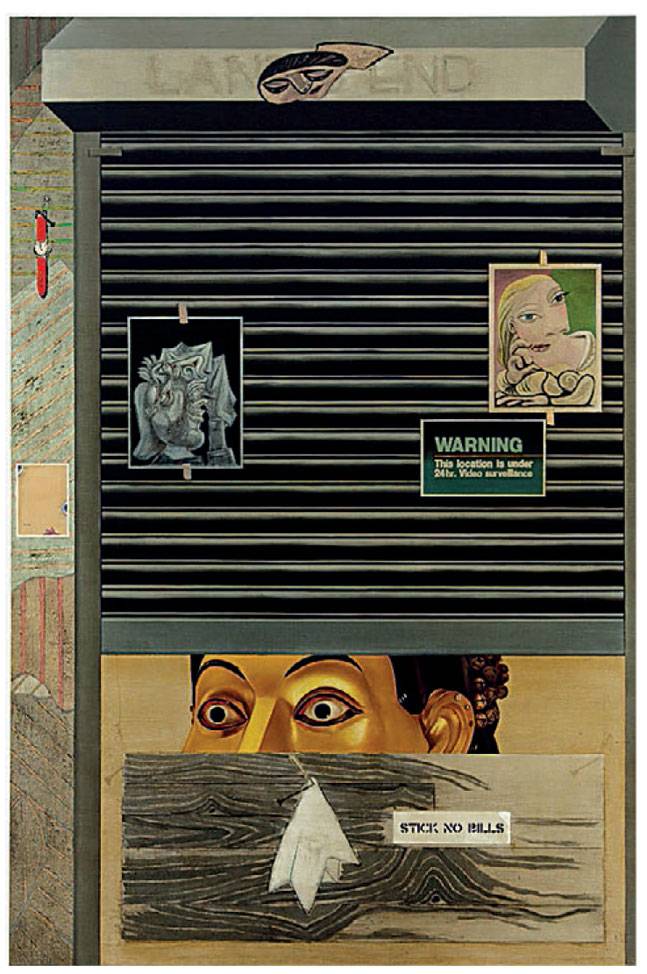
From: Atul Dodiya, November 9, 2015: India Today
With a nod to Picasso's 'guernica' without and Ravinder Reddy's sculpture within, is the warning that balancing our inspirations between western and Indian is under watch.
Heritage
Victorias
The Times of India, Jun 09 2015
Shibu Thomas
Joyride illegal; horses treated cruelly: Court
In a victory for ani mal rights activists, the Bombay high court ruled that horse-drawn car riages -locally called `Victo rias' -used for joyride along the seaside were “illegal“, and set a June 2016 deadline to phase them out. Hearing a PIL filed by Animals and Birds Charitable Trust, an NGO, a bench of Jus ices Abhay Oka and Anil Menon ordered the Brihanmumbai Municipal Corporation BMC) to shut down stables housing the horses and ponies in the city within a year.
“The activity of running Victorias driven by horses in Mumbai for joyride is completely illegal and is required to be stopped,“ said the judges, adding it also amounted to violating the Prevention of Cruelty to Animals Act.
“The activity of horse-driven carriages only for joyrides solely for human pleasure is an avoidable human activity,“ they said.
The court's decision to ban the carriages, which now ply only on Marine Drive, Nariman Point and Gateway of India, was also based on existing licensing rules, the fact that they are a safety risk and a traffic hazard on crowded Mumbai roads.
While such carriages can operate in other cities when used for public conveyance, the HC asked the state to taken action whenever they are used for joyrides. The authorities have also been asked to act against those treating the horses cruelly .
At the same time, the court has asked the state government to frame a plan for the rehabilitation of the carriage owners --Victorias are a source of livelihood to about 700 families -and the horses.
Victorias have been a feature on Mumbai streets for decades. In 1973, when the government brought in a new rule to deny renewal of licenses for the horse-driven carriages, there were around 800 Victorias in the city. By 2011, when the PIL was filed seeking a ban, there were around 130 left.
The Victorias were given licences un der a 1920 law for being used as a public conveyance. The HC said the Victorias were not presently plying for either con veyance of passengers or goods and their use was limited to joyrides.
The court also extensively relied on affidavits filed by Mumbai traffic police, who classified these carriages as a safety risk and not in public interest. “The horsedrawn carriages now serve to be an encumbrance and a great hazard on the already crowded streets of Mumbai,“ said the affidavit.
The court took into consideration the traffic police's report on the way the horses were treated -unfit horses were made to draw carriages that were overloaded with passengers and they were made to ply on concrete and tar roads without proper horse shoes.
“The horses which are used to propel the Victorias suffer from diseases and are unable to manoeuvre themselves in heavy traffic, leading to accidents,“ one of the affidavits said.
International rank
Ranking according to number and height of buildings/ 2015
The Times of India, May 31 2015

An international building database Emporis has come up with a list of top skylines of the world.Hong Kong leads the table, followed by New York City.Mumbai, with 1,596 buildings, is in the 19th position.The ranking is based on the number and height of buildings in major cities
Modern Mumbai (post-1947
2016: First International Arbitration Centre in India
The Indian Express, October 9, 2016
The country’s first International Arbitration Centre was inaugurated in Mumbai in October 2016.
The setting up of the Mumbai Centre for International Arbitration (MCIA) — which can resolve disputes between different companies or individuals — can be a step towards establishing the city as an international financial centre.
Before this, most of the global business disputes involving Indians landed in the Singapore or the London arbitration centres. The total outflow of funds to resolve such cases, complete with logistics and other related expenditure, works out to around $ 5 billion, sources said. A centre in India can significantly bring down this cost.
Apart from the infrastructure, the MCIA is backed by robust policies both at the Centre and the state, the chief minister said. Maharashtra is the first state in India to have a comprehensive arbitration policy. While dwelling on the significance of a quick disputes-redressal mechanism, Fadnavis said, “A crucial factor to establish ease of doing business and attract foreign direct investments is a healthy arbitration resolving eco-system. In this, time and space are key. A centre in Mumbai will take care of both these factors.” So far, the closest arbitration centre for India was in Singapore.
According to a study conducted by the Singapore International Arbitration Centre, almost 30 per cent of the disputes it hears annually relate to matters involving Indian businesses. Also, the number of disputes it settled between 2001 and 2013-14 shows a ten-fold increase. The MCIA is located on the 20th floor of Express Towers, Nariman Point, and is headed by CEO Madhukeshwar Desai. The 7,000-square feet facility is equipped with hi-tech, secure hearing rooms with simultaneous transcription services. It is co-chaired by Nish Shetty, Head Asia Pacific, Clifford Chance, and Vyapak Desai, partner, Nishith Desai and Associates.
It has on board leading international and domestic arbitration practitioners such as Sir Bernard Rix, Former Lord Justice, English Court of Appeal; David W Rivkin, President, International Bar Association; James Spigelman, former Chief Justice of New South Wales; Michael Pryles, former President of the SIAC Court of Arbitration; John Beechey former President of the ICC International Court of Arbitration; Christoper Lau, Supreme Court Chartered Arbitrator; Nicolas Peacock, partner, Herbert Smith; Justice Surinder Singh Nijjar, former judge of Supreme Court of India; Justice Ferdino Rebello, former chief justice of the Allahabad HC; Cyril Shroff, Managing Partner, Cyril Amarchand Mangaldas; Pallavi Shroff, managing partner, Shardul Amarchand Mangaldas; Vikram Nankani, senior advocate Bombay HC; Promod Nair, Head of Chambers, Arista Chambers; Shreyas Jayasimha, Managing Partner Aarna Law; and Nakul Dewan, advocate, Supreme Court of India.
Monsoons
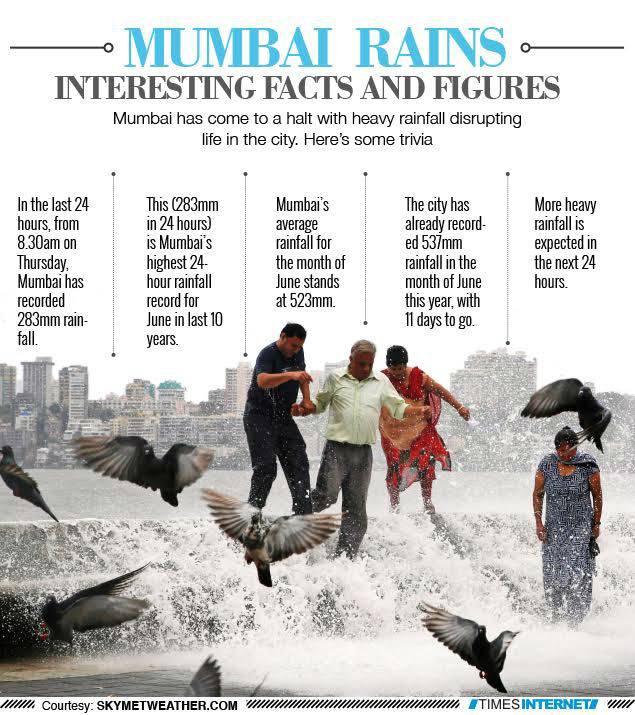
July 2017, third lowest rainfall since 2008
Richa Pinto, Mumbai sees third lowest July rainfall since 2008, Aug 2, 2017: The Times of India
HIGHLIGHTS
The rainfall recorded in June 2017 was 523.2 mm barely crossing its required average of 523.1mm for the month
In July the total rainfall recorded was 869.6mm, which again crossed the average of 799.7mm
In July 2017, the city recorded a rainfall of 869.6mm, the third lowest reading for the month since July 2008. The onset of monsoon over Mumbai this year was declared on June 12, two days after its normal date. The total rainfall recorded by the IMD Santacruz observatory from June 1 to July 31 this year has been 1,392.8mm. The rainfall recorded in June 2017 was 523.2 mm barely crossing its required average of 523.1mm for the month. In July the total rainfall recorded was 869.6mm, which again crossed the average of 799.7mm. The IMD Santacruz weather station's reading is considered to be indicative of Mumbai. Weather officials said that such variability will always be there in the rainfall reading. "The gap increases when there is a reduction in rain received in the city," said K S Hosalikar, deputy general, western region, IMD. It is also pertinent to note that July 17 this year was the city's wettest July day in three years, which led the city to meet it average target for the month.
It is observed that the city receives heavy rainfall due to a system in the Arabian sea or Bay of Bengal. The last few days of subdued rainfall in Marathwada has farmers worried over the fate of their sown crops.
Marathwada, which falls in the rain shadow area, is currently the only subdivision in central India that has slipped into the 'deficient' seasonal rainfall category. Since June 1, it has reported a 21% shortfall in rainfall.(Inputs from Neha Madaan).
South Mumbai
2018: business district cedes space to BKC, Andheri-Kurla, outside the island

From: ManthanK Mehta, CST ticket sales fall, signal a tectonic shift in Mumbai, April 26, 2018: The Times of India
SoBo Biz Dist Ceding Space To Suburbs
The name of Mumbai’s oldest railway terminus has grown longer — from VT to CST to CSMT — but the queues for local train tickets have grown shorter, with the number of tickets sold daily dropping almost 30% over the last five years alone.
The latest figures provided by Central Railway (CR) show that in 2012-13 Chhatrapati Shiva ji Maharaj Terminus in south Mumbai sold more than 2 lakh tickets per day. In 2017-18, the number had reduced to 1.44 lakh. Emergence of satellite townships and business hubs in the suburbs has altered Mumbai’s conventional north-south commuting pattern, dispersing officegoers in new directions.
Experts said the latest figures confirmed the trend that the south Mumbai business district of Fort, Nariman Point and Ballard Estate is gradually ceding space to other areas like BKC and Andheri-Kurla Road, which are outside the island city. “We have witnessed this trend of numbers falling at CSMT because offices have shifted out of south Mumbai,” CR chief public relations officer Sunil Udasi said.
The former mill land areas of central Mumbai in the Parel-Elphinstone-Currey Road belt have also become a new hub of employment. Redevelopment and large commercial housing projects have paved the way for companies in hospitality, media and finance to expand office space in these areas. “We have planned a suburban train terminus at Parel so that more originating trains can run from here to take care of overcrowding,” Udasi said.
Pankaj Kapoor of Liases Foras, a real estate research firm, said jobs have clearly moved to Parel, Andheri, Malad and Bandra-Kurla Complex.
Another contributory factor in the drop in footfalls at CSMT is that number of vehicles on the roads has more than doubled, from 22 lakh in 2012-13 to 33 lakh in 2017-18. Clearly, new road infrastructure is helping more people to opt for public or private transport.
Contrast this with the increase in the number of originating railway passengers in satellite townships outside the metropolis. In Ulhasnagar in Thane district, there has been a nearly 110% jump in passengers. In 2012-13, the number of passengers at this station was 66,363 and has now increased to 1.38 lakh. Titwala witnessed a jump of almost 46% and Badlapur of 29% in five years.
Tourist arrivals
Overnight international visitors: 2009-2015
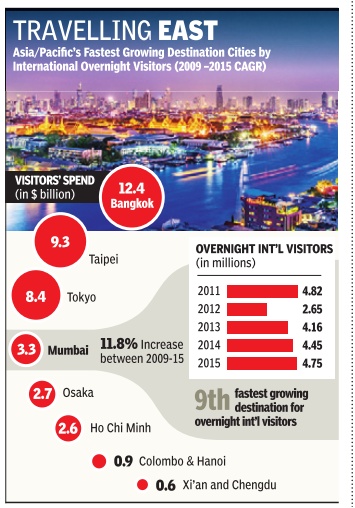
The Times of India, Jun 04 2015
Kounteya Sinha
City set for record foreign overnight visitors
Mumbai raked in a whopping $3.3 billion from visitors who stayed overnight in the city in 2015, making it the fourth most lucrative market in the Asia-Pacific for overseas spenders. Bangkok in Thailand saw the highest visitor spend in the region in 2015 -$12.4 billion followed by Taipei ($9.3 billion) and Tokyo ($8.4 billion).
As many as 4.75 million people have till now stayed overnight in Mumbai in 2015 -all set to record the highest number of international visitors who stopped by in the city in the past five years with almost half a year to go before year-end. Mumbai in 2011 recorded the highest number of overnight international visitors -4.82 million.
The growing number of tourists stopping over in Mumbai has made the city the only Indian entry in the Asia-Pacific to figure in the top 10 fast growing cities by international overnight visitors. It is now the ninth fastest growing city by international overnight visitors (2009-2015). In 2014, Mumbai saw 4.45 million international overnight visitors while in 2013, it stood at 4.16 million.
With data going back to 2009, the Global Destination Cities Index charts how 132 of the most important cities in the world are connected through air travel -how many international visitors arrive at each of these 132 cities from the other cities and how much these visitors spend during their visit.
The only year Mumbai saw a major dip in overnight tourists over the past five years was in 2012 when it recorded just 2.65 million international overnight visitors. In almost every other year, the city has had over four million such tourists.
In 2015, it is expected that 382.9 million trips will be made by international visitors by air between the 132 cities covered by the Index, spending a total of $360 billion during their visits.
According to the index, London is the world's topranked destination city with 18.82 million international visitors expected in 2015, slightly ahead of secondranked Bangkok with 18.24 million. London has topped the index in five out of seven years, except 2012 and 2013, when Bangkok held the lead position. They are followed by Paris, Dubai, Istanbul, New York, Singapore, Kuala Lumpur, Seoul and Hong Kong in the world top 10.
Colombo in Sri Lanka, interestingly , has emerged the fastest growing market with a 21.1% increase in overnight stays. Chengdu in China's Sichuan province is the second fastest with a 20.7% growth rate.
According to the index, the “prerequisite for any destination city that aspires to attract more international visitors is to increase the capacity of its airports and frequency of flight connections between the airport and the rest of the world“.
Water, drinking
2019/ Seven lakes provide the water

From: August 17, 2019: The Times of India
See graphic:
2019/ How water from seven lakes reaches Mumbai’s taps.
2019/ Tap water 99.3% safe
Clara Lewis, May 12, 2019: The Times of India

From: Clara Lewis, May 12, 2019: The Times of India
Mumbaikars can now drink water straight from the tap, Brihanmumbai Municipal Corporation’s (BMC’s) hydraulic engineer Ashok Tawadia said. According to BMC, an average 0.7% of water samples collected daily across Mumbai between April 2018 and March 2019 tested positive for coliform bacteria, a group of microorganisms present in water bodies that indicate water may not be fit for drinking. This is far better than the WHO norm of 5% limit.
This privilege comes with a caveat. Residential colonies have to ensure cleanliness of the last-mile systems — underground and overhead water storage tanks in housing societies and drums in slums. “Our water is potable and if residents can ensure their tanks are regularly cleaned, they can drink water straight from the tap,” he said.
WATER QUALITY
Disease outbreak led to Mumbai revamp
Clean drinking water ranks high among the quality of life indicators. In Mumbai, where at least a lakh of cases of severe diarrhea are reported every year in public health dispensaries and hospitals, providing water that can be consumed directly from the tap is an achievement. In the past, international agencies have noted that the water available within the BMC’s Master Balance Reservoir at Bhandup was among the purest in the world, but quality suffered by the time it reached citizens due to the poor distribution system.
Since December 2018, however, the ‘pure’ water flows across the city’s 7,000 km water distribution system. Tawadia said, “Since December, the quantity of unfit samples (containing coliform/E coli) is less than 1%.’’ In March, the number of unfit samples further dropped to 0.7%. As per international standards, less than 5% of the water samples can have coliform bacteria; these samples are further tested for faecal contamination marked by the presence of faecal coliform or E coli.
In Mumbai’s water samples sent for testing right now, only 0.15% of these 0.7% samples contained E coli— a type of coliform bacteria that is found in faeces —and the rest is coliform bacteria that is not always harmful. In public health terms, this translates into low-infection chances — less than two per 1,000 people could get an infection on account of water contamination.
The transformation in the city’s water quality started in 2012-13 after a severe outbreak of waterborne diseases in the C ward (Marine Lines, Kalbadevi, Pydhonie, etc). BMC’s laboratories revealed that 17% of the water samples collected were contaminated. That year, the BMC decided to revamp its water supply system and laboratories.
The steel water pipelines used for surface distribution were converted into underground concrete water tunnels. Today, the city has14 such underground water tunnels. The Tansa mains and other old trunk lines were changed. In slums, the numerous bunches of water pipelines laid close to sewage lines were removed and replaced with a single six- or nine-inch pipeline and connections were provided close to tenements.
(With additional reporting by Malathy Iyer)
See also: Links to Indpaedia's articles on Mumbai/ Bombay
This is a very partial list of the various pages that Indpaedia has about Mumbai/ Bombay. If a link is Red it means that the page has been renamed (normally, to something similar) and you can access it through the Search box at the top right of this page.
the Facebook community, Indpaedia.com. All information used will be acknowledged in your name. |
1
2
A-C
Bandra Parsi Convalescent Home Trust, Mumbai
The Bombay East Indian Association
The bungalows of Indian film stars
Chhatrapati Shiva ji Maharaj Vastu Sangrahalaya, Mumbai
Mumbai: Chhatrapati Shiva ji Maharaj International Airport
Mumbai: Chhatrapati Shiva ji Maharaj Terminus
Mumbai: climate, natural phenomenon
D-F
The ‘dance bars’ of Maharashtra
Film Heritage Foundation, Mumbai
G-H
Government Law College, Mumbai
Mumbai: Home page/ factfile/ general issues
I-L
Indian Institute of Technology, Bombay
Institute of Forensic Science, Mumbai
Institute of Hotel Management, Catering Technology and Applied Nutrition (IHM), Mumbai
K J Somaiya Medical College, Mumbai
Jazz and Western popular music in Goa and Bombay
M
Mumbai: migration to, from and within
Mumbai and Indian music: classical and light
N-Q
National Institute of Fashion Technology (NIFT), Mumbai
Mumbai: Parliamentary elections
R-T
Mumbai: Sanjay Gandhi National Park, Borivli
Seth GS Medical College, Mumbai
St. Stanislaus High School, Mumbai
Tata Institute of Fundamental Research
Mumbai: Theatre Mumbai: local trains
Mumbai: transportation, traffic, commuting
U-X
Mumbai: Victorian and Art Deco Ensembles